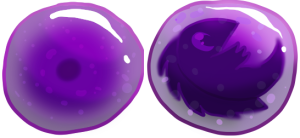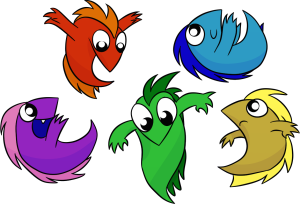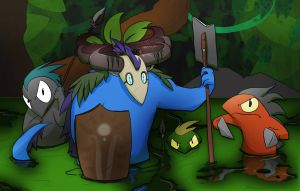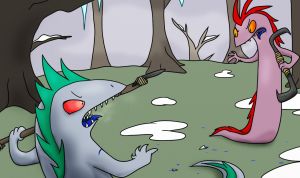Toki
Tokis are a reptilian species that reside on the planet of Tarati. They live a simple tribal life in the forests.
| Toki | |
|---|---|
| Location | Tarati |
| Diet | Omnivorous |
| Habitat | Swamps, jungles, and mountains |
| Language | Tokian |
Appearance
The distinguishing features of a toki are a shark-like head, a snake-like tail and a colourful crest running down their spine. It has three fingers and one thumb on each hand, and uses its tail to move about. It has a colourful crest down its spine.
Social Organization
The majority of tokis live a primitive lifestyle in small tribal communities ranging between 10 and 50. These tribes remain localized to a small territory where they will fish and farm for each other. Tribes may have a few stone or wooden huts to serve as personal sleeping areas, supplies storage, public spaces, and guard towers. Cultural tensions between tribes plus the lack of ability to combat predators have prevented the tokis from forming larger communities. All tokis speak a single language called Tokian. Tokian is a simple language with a wide variety of vocalizations including the throat hiss written as hh and the tooth hiss written as ss.
Culture
Toki religion is divided into two main sects. The largest of the two is Toki Mythology, elemental worship believing that everything in the universe comes from eight main compounds. The second largest religion is Kiladako worship, believing that the Kiladako are holy creators and guardians to be revered.
Anatomy
Crest
The crest is made of thick scales and cartilage. It contains sparse nerves and blood vessels. It can be stiffened slightly but it contains no muscles. It can be painful for a toki to sit on its own crest or have it damaged in any way. Some tokis will pierce their crest for cultural or cosmetic reasons. Having the crest severely damaged will not usually be fatal to the toki.
Skin
Toki skin consists of small smooth scales which are finely interlocked. This gives toki skin a more slippery and stretchy quality as opposed to tough and armored.
Teeth
The teeth of a Toki are all triangular. The teeth are removed easily if the toki is knocked in battle or takes a large bite out of something, but they always grow back. A toki will replace its teeth 8 or 9 times over its lifetime.
Tokis are blue-blooded due to using hemocyanin as an oxygen-transport metalloproteins. This trait helps them to survive the colder climate and lower oxygen densities of Tarati. This helps them survive in the Alpine Zone, and also means they can hold their breath longer underwater.
Growth
A toki egg is round, soft-shelled, purple, and about the size of a golf ball.
The egg is partly transparent, and if you look hard you can see the embryo growing inside. A toki egg has the texture of grape jelly.
After several months the baby tokis will hatch and leave the nest almost immediately. Many will never know their parents.
They are able to move, breathe and swim a few years after hatching.
A newborn toki resembles a small tadpole.
Natural Predators
Toki have several predators, including large Behemoths, Sneehogs and many types of fish and other creatures that live in the deep rivers of Tarati. They are constantly under threat by rival toki and Kiladako.
While most toki live on their own or in small groups, some kinds have managed to become sentient. They have learned how to make fire, spears, and how to work as a team. They have passed down this knowledge to their offspring and rarely communicate with the "rogue" tokis.
Diet
Full Page: Toki Cuisine
Toki are omnivores, eating fish, insects, small mammals, bird eggs, and many types of plants.
Physiology
Tarati is divided into two lands. The Snow lands are located at the very top and bottom of the planet and are covered with snow and mountains. The other land is the Jungle, which covers the equator with trees and swamps.
Just like Tarati, Toki are divided into two kinds. Snow Toki can cope with the cold a lot easier and can go for weeks without food. Jungle toki are a lot more in number and are suited to the humid forests.
Variation
Tokis are adaptable creatures to the point where they easily mutate under specific conditions. For this reason a large number of toki subspecies and genetic variants exist.
Jungle Toki
A toki whose body has adapted to a more tropical forest climate. Characteristics may include bright scale colours, particularly green, and are less resistant to cold and hunger. Jungle tokis are generally better climbers and swimmers from birth.
Snow Toki
A toki who is genetically more suited to the mountains of Tarati. Snow tokis are pale in appearance and are often more introverted. They are less agile than their jungle counterparts in exchange for a very high tolerance to the elements.
Long-Tailed toki
A toki which measures over 2 meters in length. While it may look unusual, these tokis find advantages with their height and better climbing skills.
Winged Toki
These rarely-seen tokis are rumored to have large folds of skin between their arms and tail.






